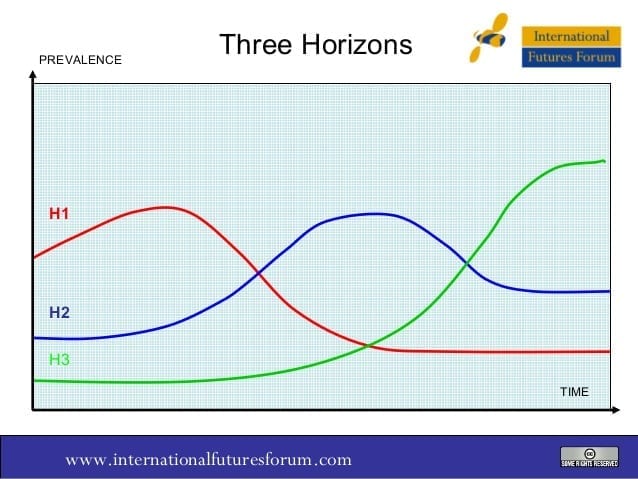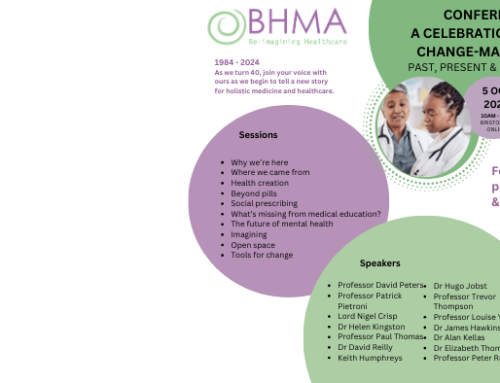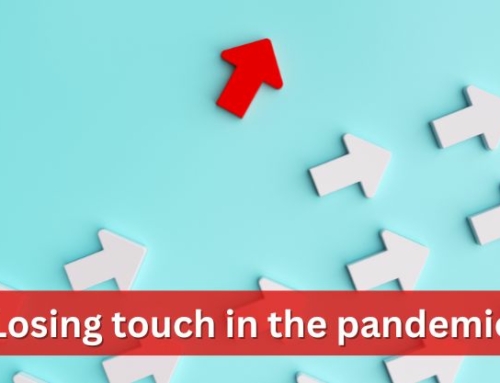For over 30 years, I’ve been involved in finding ways to think about the future, first as a research manager in the computer industry, and for the last 15 years working independently as a futures practitioner across all sorts of areas from sustainable transport to the arts and the future of healthcare.The Three Horizons practice has grown from my work with the International Futures Forum (IFF), which seeks to foster practical hope and wise initiative in the most complex issues facing our society.
The foundational practice of using three horizons is seeing everything in patterns. What this means is that we look at the world as patterns of activity that we all sustain and reproduce by taking part in them. Every day we get up and go about our business, typically doing things in much the same way as we did yesterday, and expecting to do the same tomorrow. We all rely on many patterns of life staying much the same, and expect them to be put right if something goes wrong – if a storm brings down the power lines someone comes out and fixes them. Visionaries look at the familiar, stable pattern and see its flaws, and set about bringing a new pattern into existence. From their point of view this will be a ‘better’ pattern, but we might not all agree, and even if we do, there is a lot of investment in the current way of doing things that creates huge inertia against change. So, if we are setting out to bring a new pattern into existence we have to take a wide-angle view of everything that holds the current pattern in place, and what has to change for it to be transformed. Here are six things that I find helpful to explore with people when using Three Horizons to develop their approach to transformative innovation.
Questions to explore…
Is there a way that society manages innovation of the sort we want to do?
One of the most helpful things that Three Horizon mapping reveals is the difference between sustaining and transformative innovation. In the first horizon there will typically be plenty of sustaining innovation going on, making the existing pattern function better, whatever ‘better’ means in its own first horizon terms, whether that is better fossil fuel energy systems, better antibiotics, or better weapons. Transformative innovation brings into being things that the first horizon pattern would just not do – such as the shift to renewable energy from fossil fuels, for example.
As we explore our area of concern there are broadly two situations that are revealed by a Three Horizons mapping exercise, distinguished by whether or not we have arranged society to support the process of transformative innovation. For example, in democracies we have invented a social system that is generally able to accommodate change in policy, and the constitution within which policy is made, without the need for collapse and renewal of the system of governance itself. In earlier times, and still in other parts of the world, we are familiar with societal change requiring civil war, revolution, collapse or some other discontinuous change in the institutions of governance themselves.
Similarly in market economies, we structure the three horizons in such a way that both sustaining and transformative change is enabled: we have the established companies in the first horizon that we expect to provide some stability, innovators funded by venture capital in the second horizon trying out new ideas, and third horizon research in universities that opens up new territory and prepares the ground for what Schumpeter called ‘creative destruction’ in which the new sweeps away the old – the way the www. has swept away many familiar ways of doing things.
Many of our social systems, such as education and health, are set up to prioritise stability and consistency over renewal. This means that while sustaining innovation can be achieved and is actively supported, it is very much harder to bring about transformative change to a new third horizon. In tackling this, one response is to import market-based innovation into the system, but this of course brings many other problems. The challenge is to develop approaches to transformative change that can be used appropriate to the situation. The growing interest in the theory and practice of ‘systems change’, including my IFF colleagues’ work on developing a robust infrastructure to support transformative innovation, provides some encouragement for the future.
What pre-determined factors are creating conditions for change?
Within the third horizon we need to distinguish those things that can be known from those that are inherently uncertain or ambiguous; and what we can influence from what we can’t.
Paradoxically, the further out we look the more certain some things become. Like snow that falls in the mountains in winter and will surely flow as floodwater to the valleys in summer, there are emerging realities that lie beyond our control that are part of the landscape of the future to which we will have to adapt. In futures work these are given the name ‘predetermined factors’. Finding them is an important step in framing transformative action so that we work with the grain of change.
For example, the spread of digital technology into the printing industry has played the role of a predetermined factor for a couple of decades now and continues to restructure more and more areas. Demographic changes are another powerful factor, with ageing populations driving change throughout health and social care, while pervasive access to online health information is dramatically shifting our relationship with health professionals.
We are most likely to be successful in bringing about change when we can align ourselves with powerful predetermined factors that surround our area of concern and configure them to the vision we are championing.
Who configures the current pattern, and are they going to be the ones to drive the change?
A societal pattern of life is held in place by three underlying behaviours: producing, using, and governing. These roles can be combined in one person or spread out across society. In my home I cook the meal, eat it, and maintain the ‘rules’ of what to eat and not to eat and how much to spend on it. This behaviour is embedded in patterns at local, national, and international levels in which these roles are played by food producers, consumer behaviour, and rules on food production, trade deals and so on.
Transformative innovation has to encompass all three of these behaviours and any one of them may be the origin of, or major barrier to, change. The fate of GM food illustrated this, with producers championing change, resisted by consumers, with governments caught between. Some changes can be instigated by user behaviour and activism that engages governance – like gender rights – but others cannot happen without sustained innovation from producers supported by governance – the shift to electric vehicles for example.
Bottom up innovation can be successful by operating on the margins of the existing system, engaging as little as possible with the first horizon mainstream producers and governance, recruiting users into a new pattern. This is the classic model of ‘disruptive innovation’ – finding new users for a new approach, offering something quite different, building up momentum until you are able to challenge the status quo.
Can we configure new resources for what we want to do?
It is easiest for new patterns to get going when they harness resources that are not captured by the existing system. The web opened up a whole field of fresh ways to do things that fuelled the dotcom boom as entrepreneurial ventures rushed into the unoccupied second horizon space. This boom was followed by bust as many of these ventures failed, but out of that time have come the new dominant players such as Amazon, Google, Facebook, Apple and many others that have restructured old industries.
It can be very creative to think about the third horizon in terms of what sort of abundance is being configured, and who is taking on the role of producer. The success of social media is in large part because it aligned with our desire to communicate and sustain relationships – a desire that seems to expand to fill the available space, just as our desire to travel fills the roads. It can be particularly difficult to pioneer change that harnesses our own role as producers but does not align with significant market opportunities – this is illustrated for example by the challenge of shifting people out of cars to walk and cycle.
Is there momentum building for change, and who might be the prime movers to configure a new regime?
It is very noticeable when you facilitate a three horizon conversation whether you are getting lots of examples of third horizon visions and second horizon innovations. If people quickly list lots of second horizon initiatives they know about and third horizon ‘pockets of the future in the present’ it means that change is under way on a broad front and the question then becomes which vision of the third horizon will prevail, and who are the prime movers who will shape it.
By contrast, in some three horizon sessions we hear an aspirational vision of a better world, but very few examples or evidence of visionaries and entrepreneurs attempting to bring such a vision about. Between these two extremes a common situation is that there is quite a lot of visionary action creating pockets of the future, but little sign of broader momentum in the system. First horizon systems can tolerate a lot of innovation around the margins without changing. If there are no major pre-determined factors putting pressure on the first horizon system, or opening up opportunities in the third, then we cannot expect visions to get much traction for change.
Can we convene the future?
Turning from analysis to action the question to ask ourselves as innovators is whether we can assemble enough of the third horizon pattern we aspire to that it can grow and attract resources. If our ambition is purely local we may be able to survive within the dominant social first horizon and become a pocket of the future. But if we want to shift the whole system then we will need to enrol and mobilise the community of producers, users and governance in such a way that they can eventually take over resources from the first horizon. This convening of the future will go through stages, where first we stand apart from the first horizon, not allowing it to prevent our innovation. Then we have to start enrolling the players who can grow a complete pattern, and then we have to mobilise the change that will shift resources from the first horizon into the third, which itself will then become the dominant, stable first horizon pattern.
Where are we in healthcare?
I have been around many discussions about healthcare using Three Horizons, and my colleagues in the International Futures Forum have written up our experience in this area in detail (IFF, 2018), but I am not an expert in health and my comments are those of an outsider.
The first horizon pattern of healthcare faces many challenges but also has a very strong system of sustaining innovation. New discoveries open up ever more, and ever more expensive, ways to treat a widening set of health conditions, and bring them within the existing model of treatment. The first horizon is not going to lose momentum in the near future, despite the many challenges it faces. Innovation will therefore have to get going around the margins of the existing system and build up its own momentum in areas where it can bring something really new into existence. Attempts to bring about transformative change within the system will typically only be tolerated until they really challenge for resources.
All around the world there are many pockets of the future in the present that are promising examples of such really new approaches that could grow in scale and scope. There is a strong resonance with emerging need as we see the growing epidemics of chronic life conditions for which the conventional approach has no solution. Many of the technology trends that reinforce the existing system can also empower new models of provision, bringing people together to support their own flourishing in new ways.
At least in the UK, the routes to change therefore are about transformative innovation management, looking for those visionary leaders in the system who are suffering from the emerging failures of the first horizon and can create space for the new to grow. What we have learned in the IFF is that to get started the first horizon has not just to say ‘no’ – it has to create a space in which the new system can get going at a small level to test itself out. Then it needs time to complete a design of all the elements of producing, using and governing. And then it is ready to grow, and the first horizon needs to say ‘yes’ and start to provide real resources. The leadership to achieve this is different to first horizon leadership, and relies on the capacity to manage the dilemma between sustaining the first horizon – we cannot allow the existing system of care to collapse – while navigating the pathway to the third.
This article comes from the spring 2018 FREE edition of the Journal of Holistic Healthcare.
IFF, 2018 (in press) SHINE: Changing the Culture of Care. Fife: International Futures Forum.
Bill is an independent researcher in science, technology and society and a Visiting Professor at the Digital Cultures Research Centre, University of the West of England.








